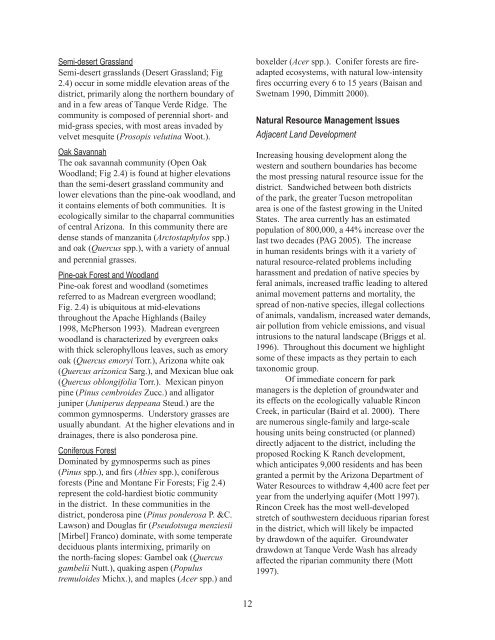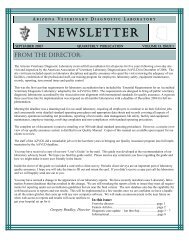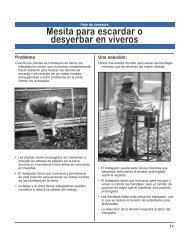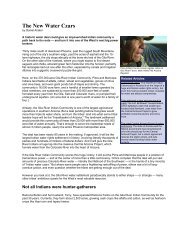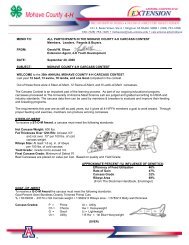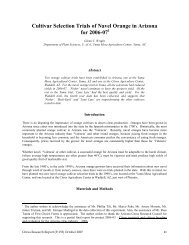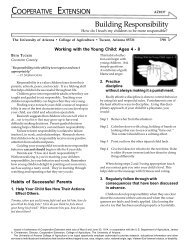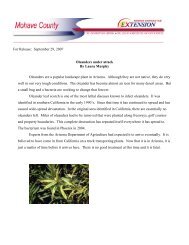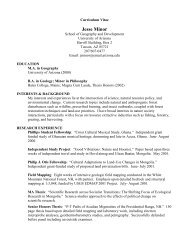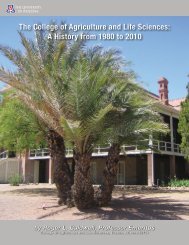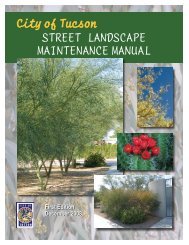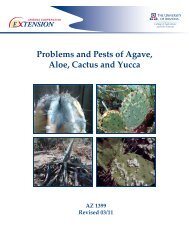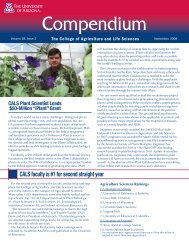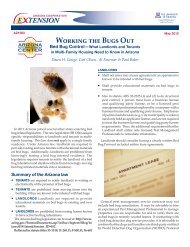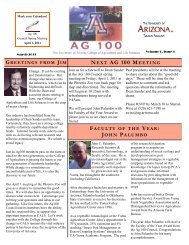Details - CALS Networking Lab - University of Arizona
Details - CALS Networking Lab - University of Arizona
Details - CALS Networking Lab - University of Arizona
You also want an ePaper? Increase the reach of your titles
YUMPU automatically turns print PDFs into web optimized ePapers that Google loves.
Semi-desert Grassland<br />
Semi-desert grasslands (Desert Grassland; Fig<br />
2.4) occur in some middle elevation areas <strong>of</strong> the<br />
district, primarily along the northern boundary <strong>of</strong><br />
and in a few areas <strong>of</strong> Tanque Verde Ridge. The<br />
community is composed <strong>of</strong> perennial short- and<br />
mid-grass species, with most areas invaded by<br />
velvet mesquite (Prosopis velutina Woot.).<br />
Oak Savannah<br />
The oak savannah community (Open Oak<br />
Woodland; Fig 2.4) is found at higher elevations<br />
than the semi-desert grassland community and<br />
lower elevations than the pine-oak woodland, and<br />
it contains elements <strong>of</strong> both communities. It is<br />
ecologically similar to the chaparral communities<br />
<strong>of</strong> central <strong>Arizona</strong>. In this community there are<br />
dense stands <strong>of</strong> manzanita (Arctostaphylos spp.)<br />
and oak (Quercus spp.), with a variety <strong>of</strong> annual<br />
and perennial grasses.<br />
Pine-oak Forest and Woodland<br />
Pine-oak forest and woodland (sometimes<br />
referred to as Madrean evergreen woodland;<br />
Fig. 2.4) is ubiquitous at mid-elevations<br />
throughout the Apache Highlands (Bailey<br />
1998, McPherson 1993). Madrean evergreen<br />
woodland is characterized by evergreen oaks<br />
with thick sclerophyllous leaves, such as emory<br />
oak (Quercus emoryi Torr.), <strong>Arizona</strong> white oak<br />
(Quercus arizonica Sarg.), and Mexican blue oak<br />
(Quercus oblongifolia Torr.). Mexican pinyon<br />
pine (Pinus cembroides Zucc.) and alligator<br />
juniper (Juniperus deppeana Steud.) are the<br />
common gymnosperms. Understory grasses are<br />
usually abundant. At the higher elevations and in<br />
drainages, there is also ponderosa pine.<br />
Coniferous Forest<br />
Dominated by gymnosperms such as pines<br />
(Pinus spp.), and firs (Abies spp.), coniferous<br />
forests (Pine and Montane Fir Forests; Fig 2.4)<br />
represent the cold-hardiest biotic community<br />
in the district. In these communities in the<br />
district, ponderosa pine (Pinus ponderosa P. &C.<br />
Lawson) and Douglas fir (Pseudotsuga menziesii<br />
[Mirbel] Franco) dominate, with some temperate<br />
deciduous plants intermixing, primarily on<br />
the north-facing slopes: Gambel oak (Quercus<br />
gambelii Nutt.), quaking aspen (Populus<br />
tremuloides Michx.), and maples (Acer spp.) and<br />
12<br />
boxelder (Acer spp.). Conifer forests are fireadapted<br />
ecosystems, with natural low-intensity<br />
fires occurring every 6 to 15 years (Baisan and<br />
Swetnam 1990, Dimmitt 2000).<br />
Natural Resource Management Issues<br />
Adjacent Land Development<br />
Increasing housing development along the<br />
western and southern boundaries has become<br />
the most pressing natural resource issue for the<br />
district. Sandwiched between both districts<br />
<strong>of</strong> the park, the greater Tucson metropolitan<br />
area is one <strong>of</strong> the fastest growing in the United<br />
States. The area currently has an estimated<br />
population <strong>of</strong> 800,000, a 44% increase over the<br />
last two decades (PAG 2005). The increase<br />
in human residents brings with it a variety <strong>of</strong><br />
natural resource-related problems including<br />
harassment and predation <strong>of</strong> native species by<br />
feral animals, increased traffic leading to altered<br />
animal movement patterns and mortality, the<br />
spread <strong>of</strong> non-native species, illegal collections<br />
<strong>of</strong> animals, vandalism, increased water demands,<br />
air pollution from vehicle emissions, and visual<br />
intrusions to the natural landscape (Briggs et al.<br />
1996). Throughout this document we highlight<br />
some <strong>of</strong> these impacts as they pertain to each<br />
taxonomic group.<br />
Of immediate concern for park<br />
managers is the depletion <strong>of</strong> groundwater and<br />
its effects on the ecologically valuable Rincon<br />
Creek, in particular (Baird et al. 2000). There<br />
are numerous single-family and large-scale<br />
housing units being constructed (or planned)<br />
directly adjacent to the district, including the<br />
proposed Rocking K Ranch development,<br />
which anticipates 9,000 residents and has been<br />
granted a permit by the <strong>Arizona</strong> Department <strong>of</strong><br />
Water Resources to withdraw 4,400 acre feet per<br />
year from the underlying aquifer (Mott 199 ).<br />
Rincon Creek has the most well-developed<br />
stretch <strong>of</strong> southwestern deciduous riparian forest<br />
in the district, which will likely be impacted<br />
by drawdown <strong>of</strong> the aquifer. Groundwater<br />
drawdown at Tanque Verde Wash has already<br />
affected the riparian community there (Mott<br />
199 ).


